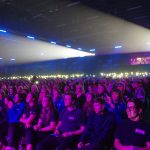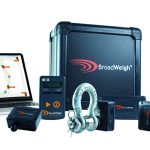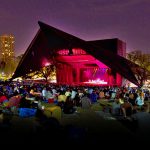With the release of their first album in seven years, Humanz, Blur frontman Damon Albarn and illustrator Jamie Hewlett took their virtual band Gorillaz on the road this year, performing with live musicians and a long roster of guest artists on both sides of the Atlantic along with a few dates in Asia and the Middle East.
The large ensemble of musicians on stage include a half dozen backup singers, keyboards, guitars and drums along with Albarn and Hewlett. They perform before a 50-by 25-foot (WxH) Saco 6mm LED wall/ backdrop provided by Solotech. The virtual band performed in the U.S. and Canada for two legs with lighting provided by 4Wall, from July 8-17 and Aug. 11-Oct. 15.
On screen, Gorillaz cartoon characters perform amid their surreal worlds. Matt Pitman’s lighting design perfectly frames the upstage video screen with sidelight and downlight, keeping the band almost in silhouette, while still creating dynamic aerial effects with the rest of the rig. The only front light comes from two truss spots downstage left and right on Albarn or one of the many featured guest vocalists.

First Tour in Seven Years
Production manager Joel Stanley explains the beginnings of Gorillaz’ first return to the road after the Oct. to Dec. 2010 “Escape to Plastic Beach” tour, in support of Gorillaz’ Plastic Beach album, released earlier that year.
“Last December, their management team, elevenmgmt, hired Gideon Berger and Stephen Gallagher of Block9 to animate and create the digital content from Jamie’s artwork. We also went into the production design phase of the tour by creating a club show, theater show, arena show and a festival show, as we knew the itinerary would involve the entire spectrum of venues,” Stanley says.
“The one scenic element that made it different, rather than just an upstage video wall at the back of the stage, is the flying gag,” Stanley adds. “It’s a round automated video set piece, or ‘The Oracle,’ as we call it.”
The Oracle is designed to be the “all seeing eye” of the show, tying into and accenting the content of all the songs from the latest album. After several iterations, the design team settled on a circular video panel requiring both rectangular and triangular 9mm tiles with a banded frame surrounding it.
“The creative team brought me some great ideas; I just had to rework them a bit to make it a functional touring piece,” Stanley says. He called upon Tait Towers and gave them about eight weeks lead time to develop the concept needed to turn this vision into reality.

“I also spoke in a lot of detail with my video supplier in the U.K., Universal Pixels, because I wanted to find a product that was really lightweight as well. This tour is going ‘round the world so we knew we would run into weight issues.” In the end a decision was made to have the Oracle comprised of Glux 9mm tiles.
Mattie Jobson is the scenic LED tech looking after the Oracle. “The triangular tiles lay at the outer edge of the screen, rotating clockwise to complete the circular image,” she notes. “This threw the pixels in disarray, so Rich Porter, our media engineer, broke the tile images down into smaller squares and fed that info to the d3, which handled all the math and made simple work of aligning the images.”
Three 64 FPM variable speed Kinesys inverted ½ ton motors sit inside a 20-by-30-foot super truss from which The Oracle hangs and moves. Kinesys automation is used with Vector software control.
For cable management, Tait Towers mounted a cable reel into a framed cage grid cheseboro’d to the top chords of the truss. The spring pressure-loaded cable reel, German made, has a plastic track to manage the data and power cable runs as the piece moves, rather than chain sliders.
Video director Jason Varner cuts the cameras for the I-Mag side screens, with imagery captured from two long lens cameras, two handheld cameras and two robotic cameras. A pair of Christie HD 20K projectors light up the side screens with the I-Mag from back in video village. At FOH, meanwhile, Rich Porter handles the d3 media servers feeding content to The Oracle and the upstage LED wall.
The Humanz tour will continue in Europe and the U.K. this month before heading to South America later in December and early next year.
Gorillaz Humanz Tour
Crew
- Production Manager: Joel Stanley
- Tour Manager: Craig Duffy
- Stage Manager: Ethan Merfy
- Lighting Designer: Matt Pitman
- Lighting Co: 4Wall
- Video Cos: Solotech, Universal Pixels
- Solotech Crew: Jason Varner (Video Director/Crew Chief), Greg Correia (Video Shader/LED Tech), Kyle Andrada (LED Tech/Camera Operator)
- Scenic LED Tech: Mattie Jobson
- Media Server Engineer: Richard Porter
- Artwork: Jamie Hewlett
- Animation/Video Content: Gideon Berger, Stephen Gallagher/Block9
- Set/Rigging Cos: Tait Towers, Atlanta Rigging Systems
- Production Rigger: Yose Lawson
- Automation/Kinesys Rigger: Dan Kirby
Gear
Video/Rigging:
- 1 Saco S6mm LED Wall (50’ x 25’ WxH)
- 1 HD 2ME Ross Carbonite Black switcher
- 2 Long Lens (Grass Valley LDX86 Cameras w/ 99x Lenses)
- 2 Hand Held (Grass Valley LDX86 Cameras/stage and pit)
- 2 Panasonic robotic cameras
- 1 Mini camera
- 2 HD Christie 20K Roadsters for side screens
- 2 21’x12’ rear fast fold screens
- 3 64 FPM variable speed ½-ton Kinesys converted
- 1 Vector control software setup
- 1 Customized automation grid truss setup
- 8 2-ton hoists
- 36 1-ton hoists
- 14 ½-ton hoists


